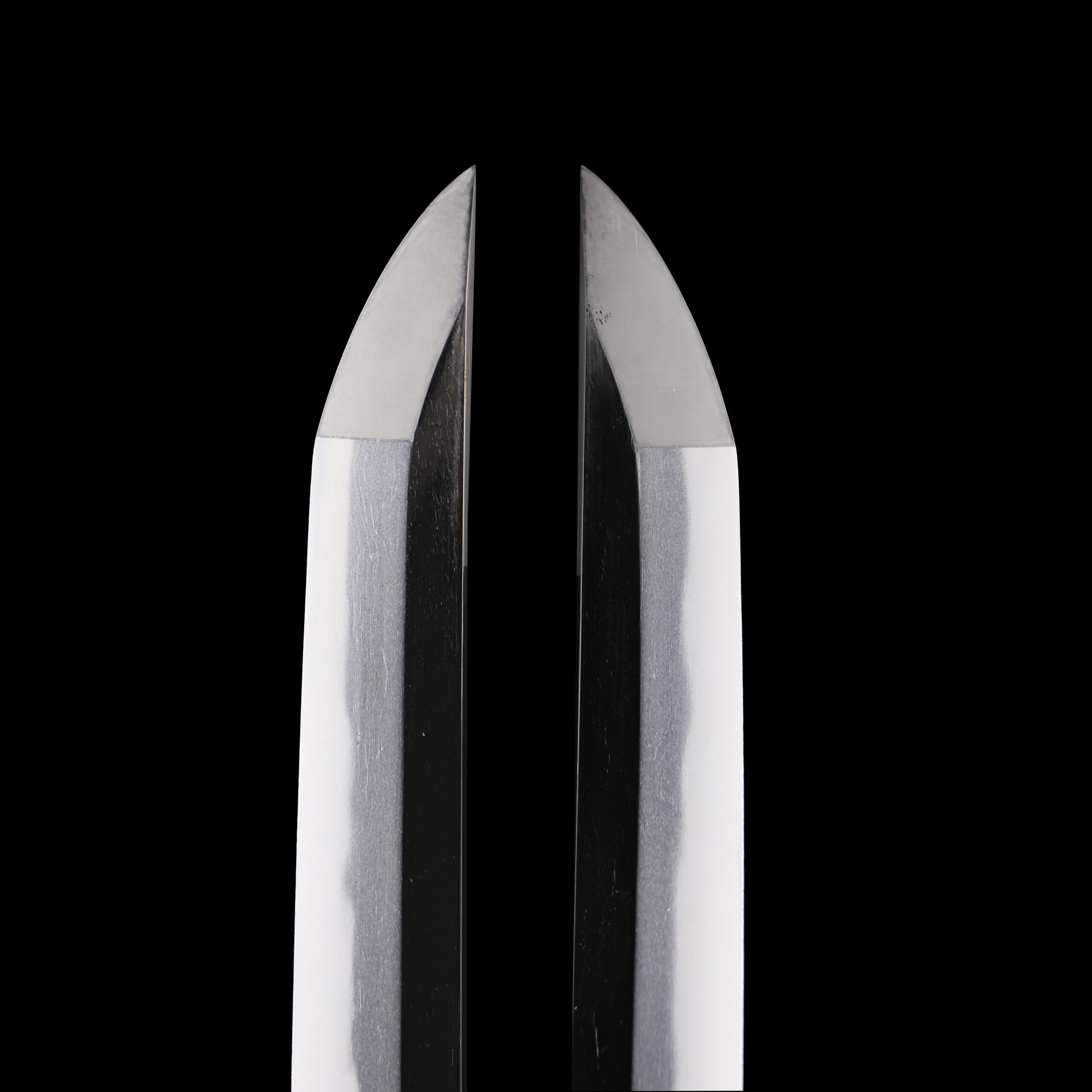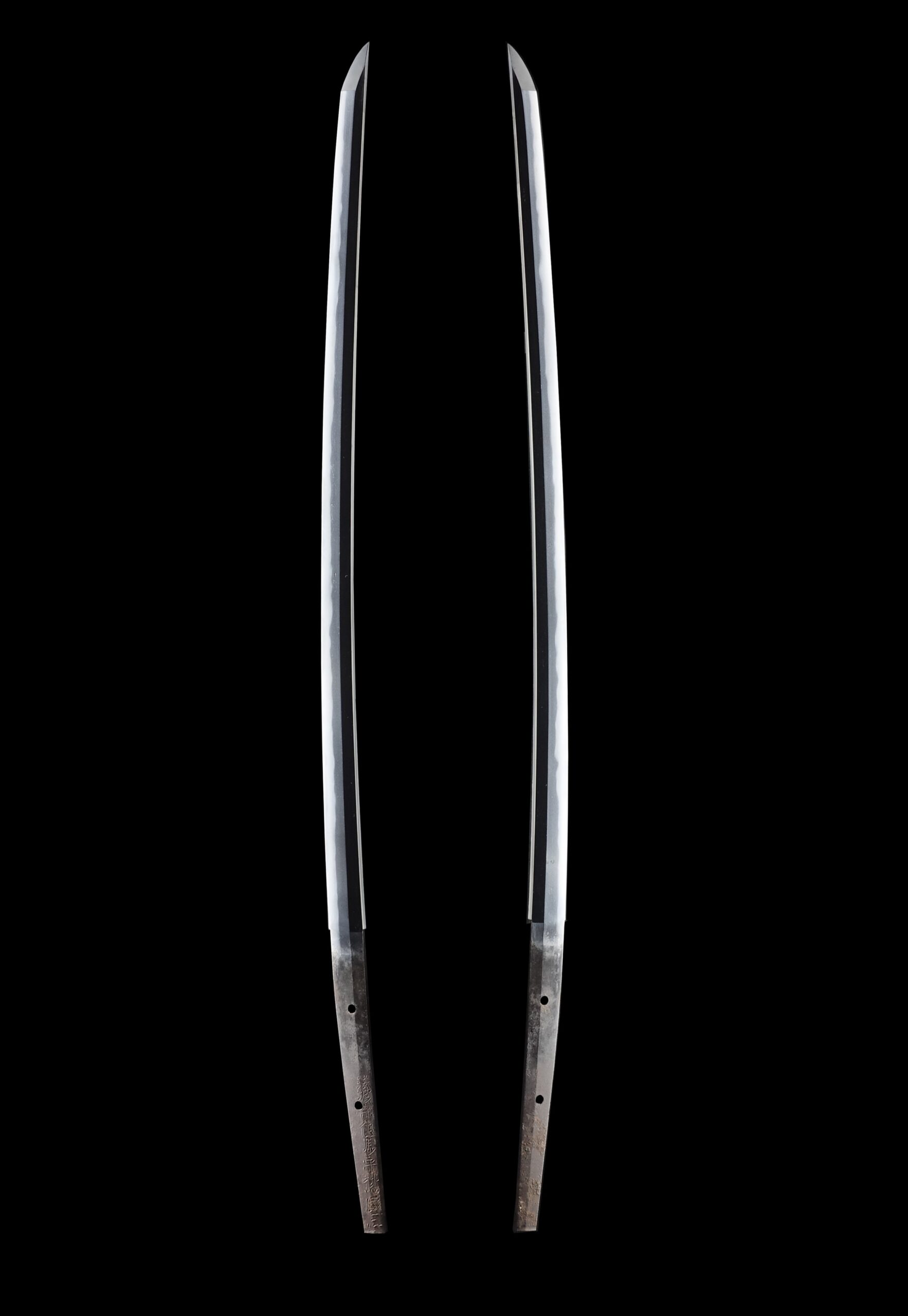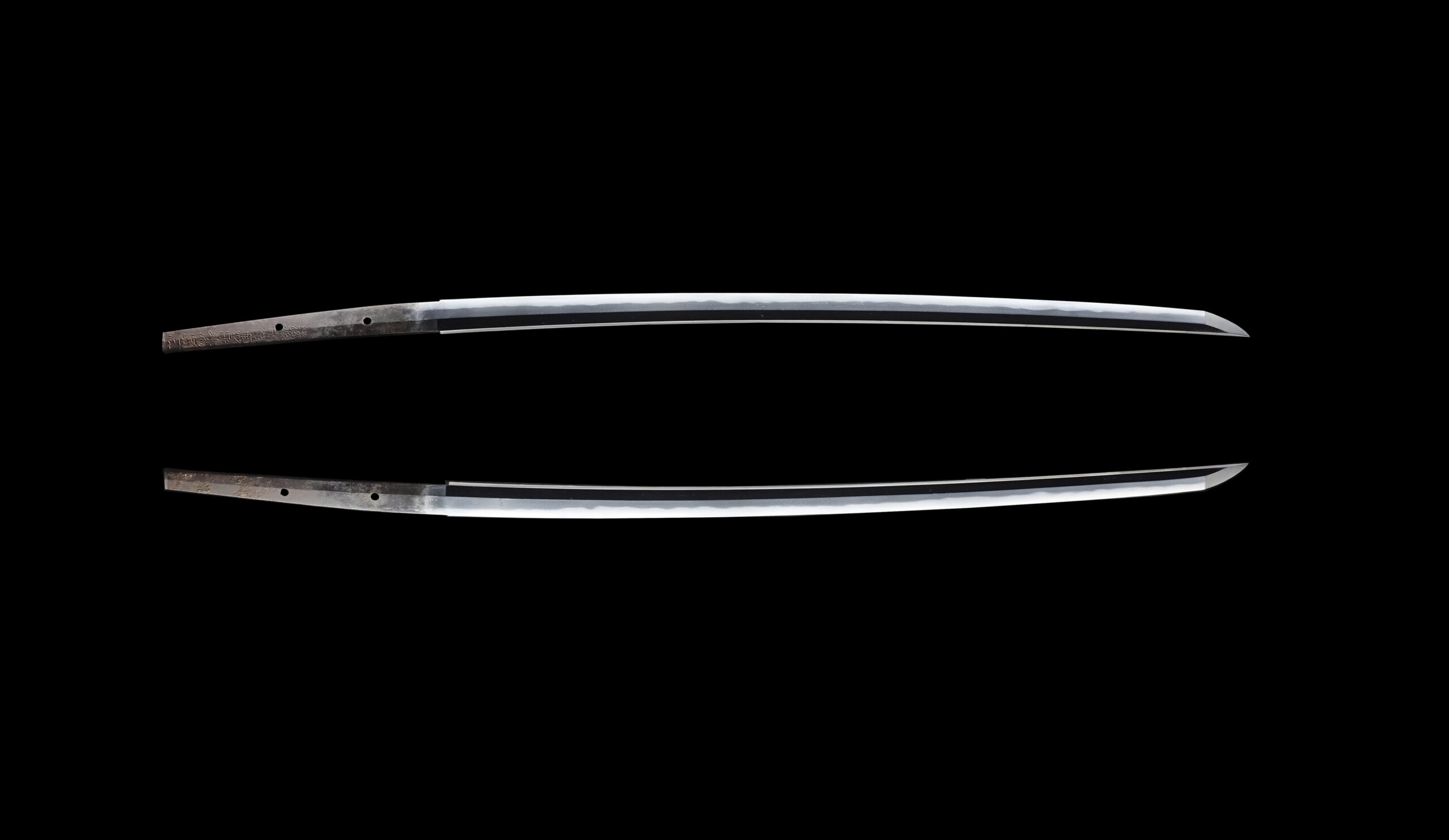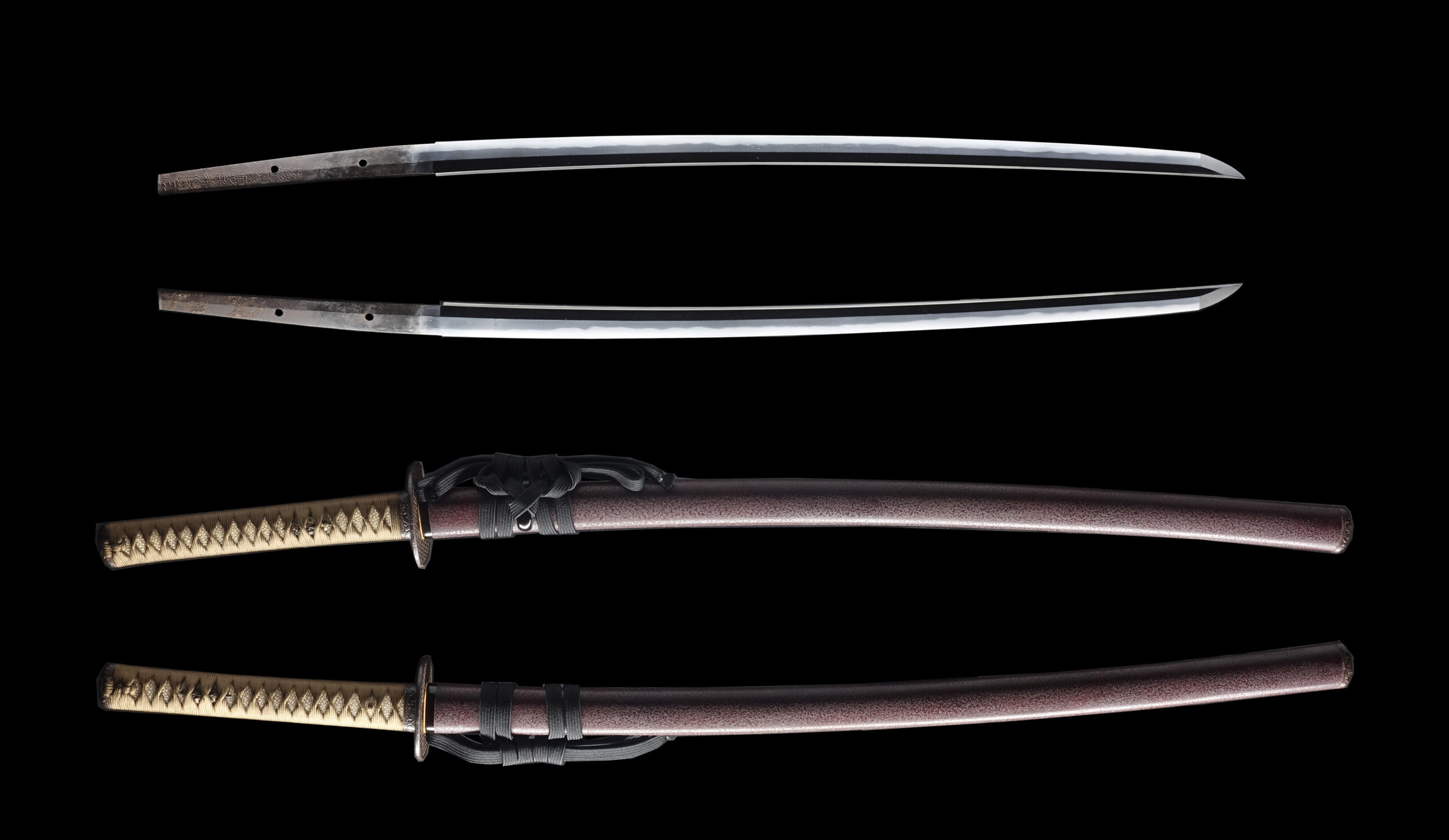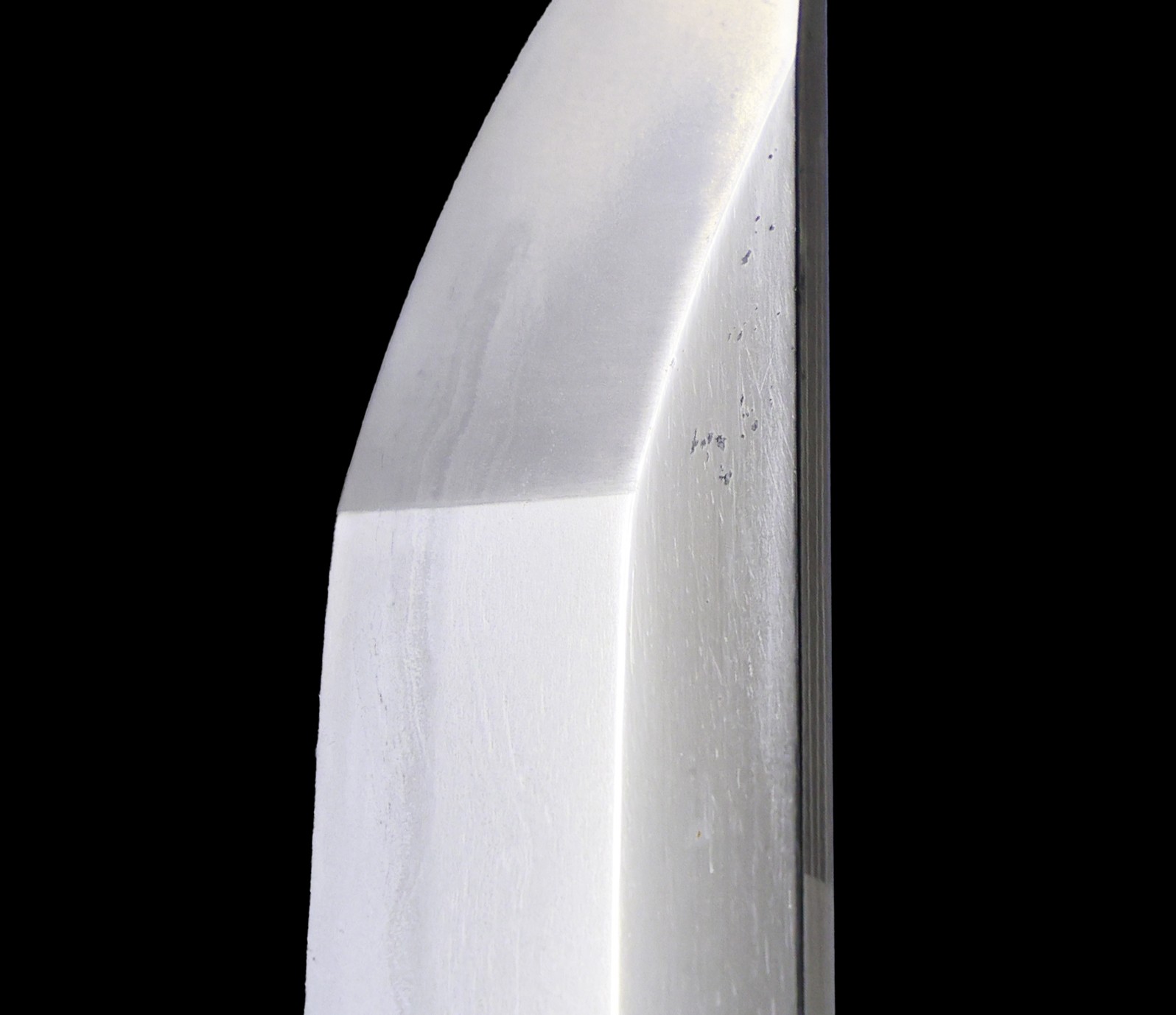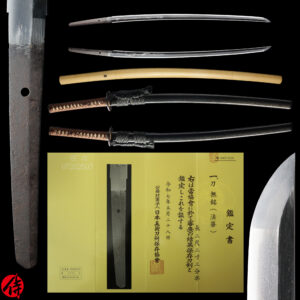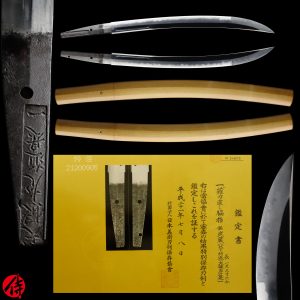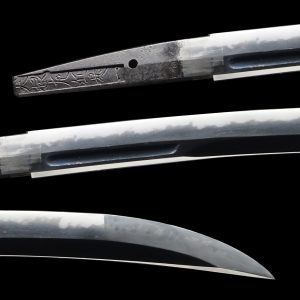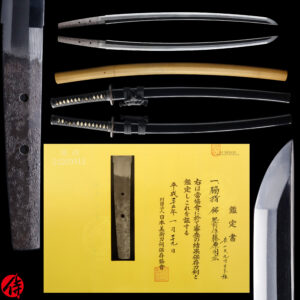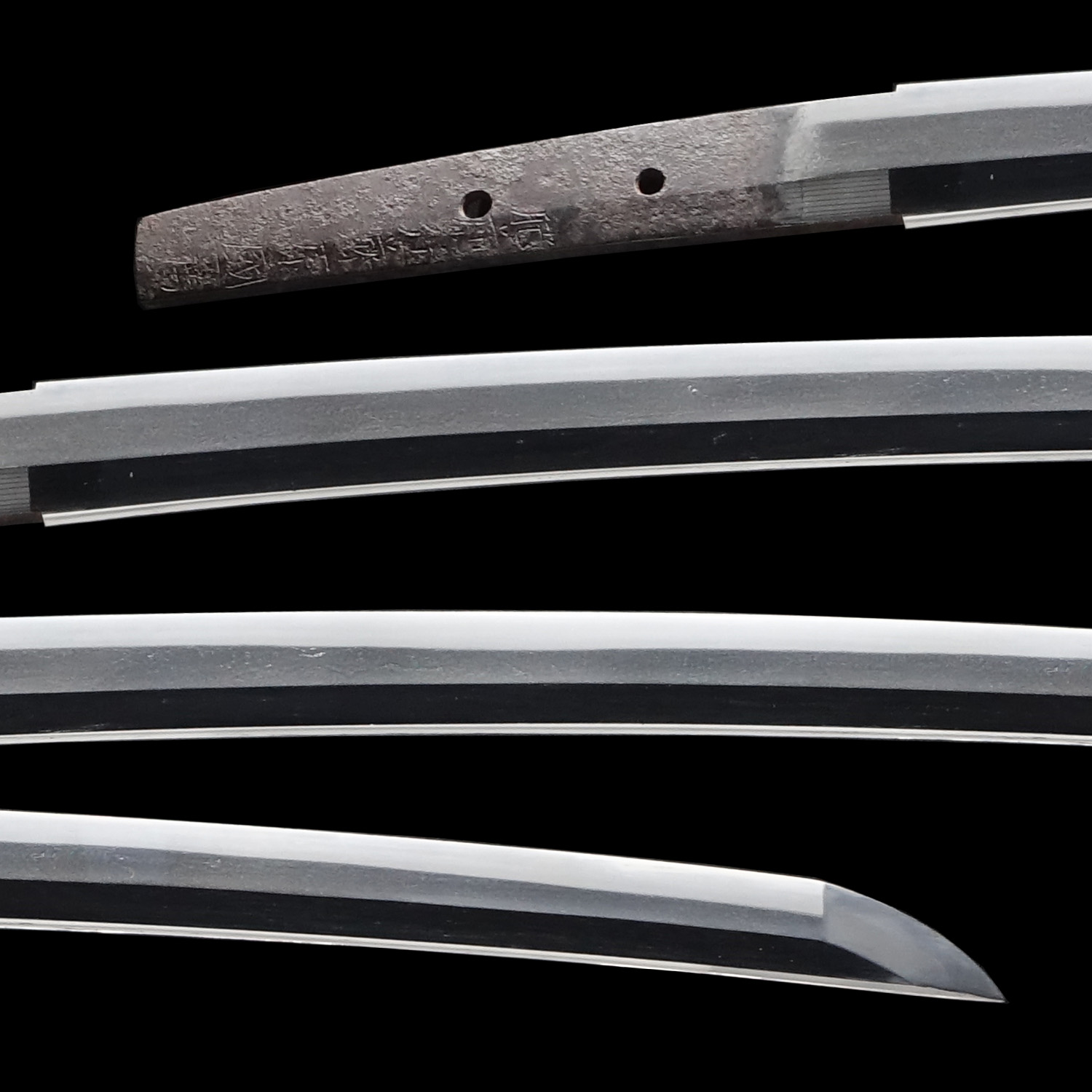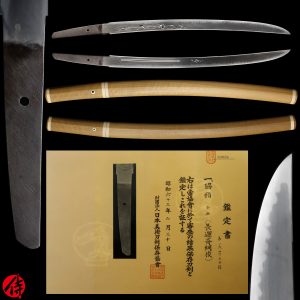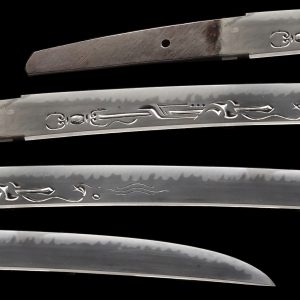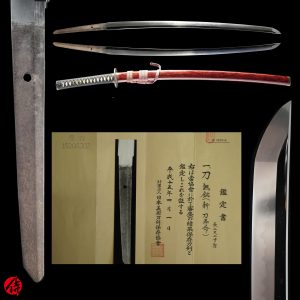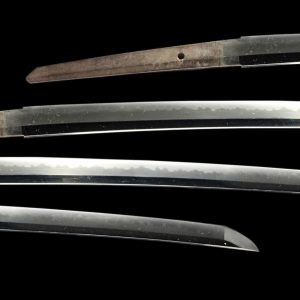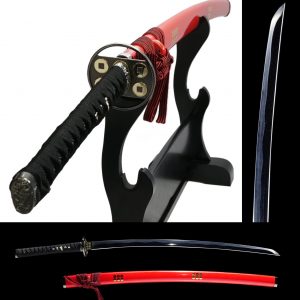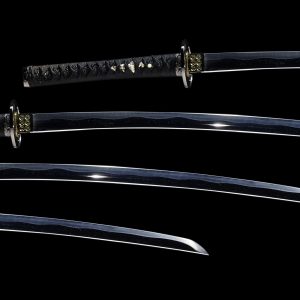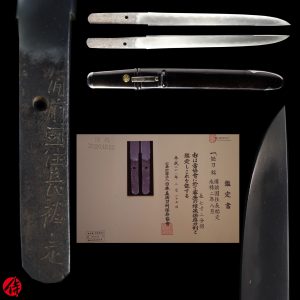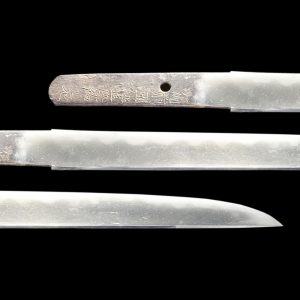Antique Japanese Sword Katana Signed by Kunimasa with NBTHK Tokubestsu Hozon Certificate
【Description】
This blade was signed by Hojoji Tajima no Kami Tachibana Kunimasa (法城寺但馬守橘国正). Hojoji is the name of the prestigious school he was part of, and Tajima no Kami is an honorable official title for his excellent craftsmanship. Tachibana is his last name.
He was active during the early Edo period (1673-1688) and one of the most prominent figures in the school in Edo city (Today’s Tokyo). Since Kunimasa was a highly regarded swordsmith, this blade might have been made for a high-class Samurai who resided in Edo. Based on the back of the signature, this blade was created when he was 48 years old when he mastered a high level of craftsmanship.
Hojoji school was founded by Hojyoji Kunimitsu, a renowned swordsmith in Tajima no Kuni (Today’s Hyogo prefecture) during the late Nanbokucho-Muromachi period. It is said that Kunimitsu was one of three apprentices of Sadamune, who was one of the most prominent makers in Soshu province (Today’s Kanagawa prefecture).
Hojyoji Masahiro (法城寺正弘), an offspring of Kunimitsu, is the one who moved to Edo city and established the Edo Hojyoji school during the early Edo period. He brought his apprentices, including Kunimasa from Tajima no Kuni, based on available records. And those who came to Edo city with Masahiro received the last name of Tachibana.
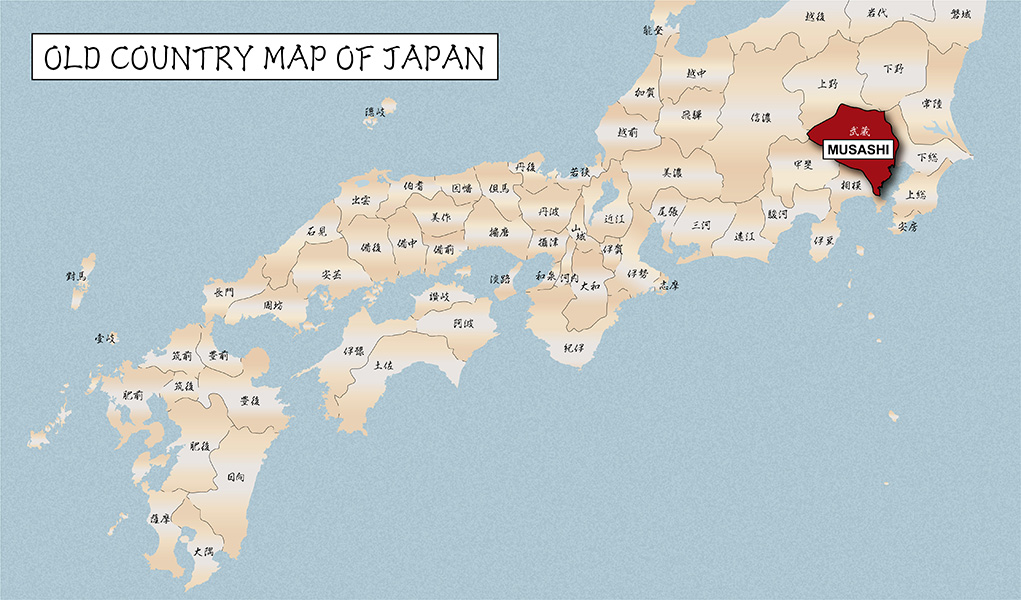
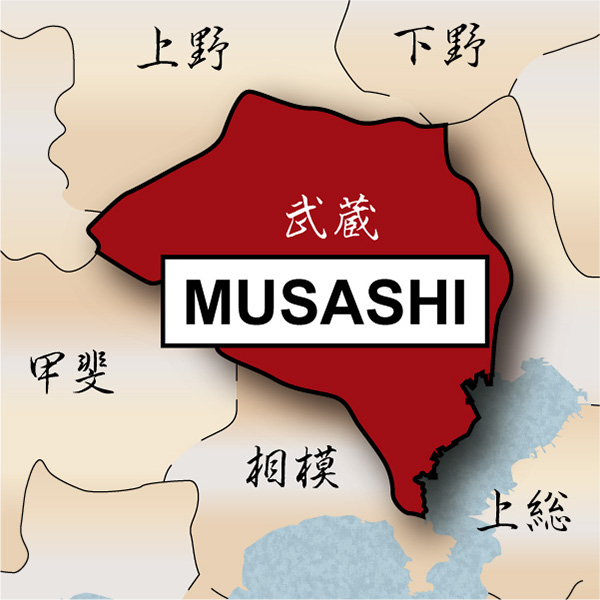
The blades forged by members of Edo Hojyoji swordsmiths closely resemble Kotetsu, one of the most famous swordsmiths. Other renowned swordsmiths who belonged to this school are Kaneshige, Sadakuni, and Yoshitsugu. The school was prosperous during the Edo period and forged many blades for the Edo government. The founder, Masahiro, once resided in Mito domain (today’s Ibaraki prefecture) to forge swords for Tokugawa Mitsukuni.
This blade is appraised as a Tokubetsu Hozon Token(特別保存刀剣) issued by NBTHK(Nihon Bijutsu Touken Hozon Kyokai:日本美術刀剣保存協会). This authentication paper was only given to authentic Japanese swords, especially well preserved and high quality with artistic value.
*Please keep in mind that there is a couple of Kitae Kizu near the tip of this blade. If you like to see the detailed condition, please feel free to contact us.
【Blade】
Cutting Edge Length(Nagasa): 63.6 cm ( 25.0 inches)
Curvature(Sori):1.0 cm ( 0.39 inches)

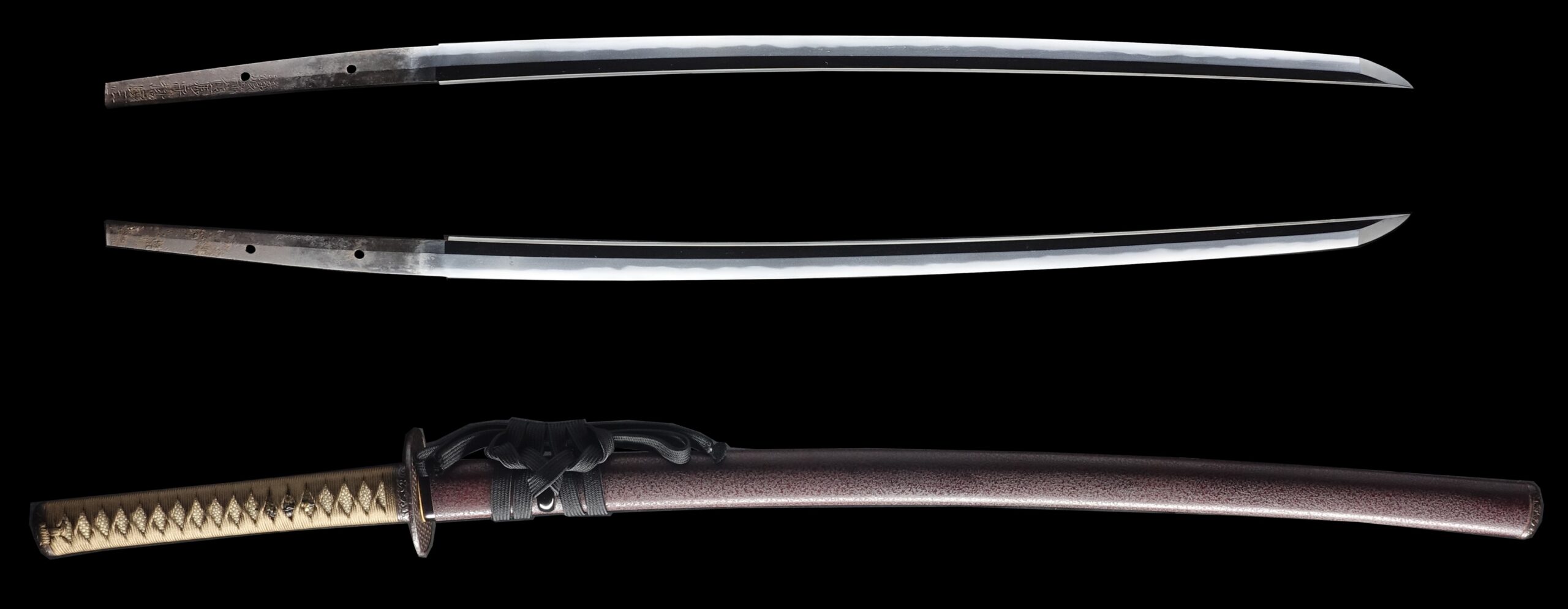
Hamon:
The crystalline structure which forms along the cutting edge of a blade as a result of the hardening process
Jimon(Jihada):
visible steel surface pattern created by folding and hammering during forging process
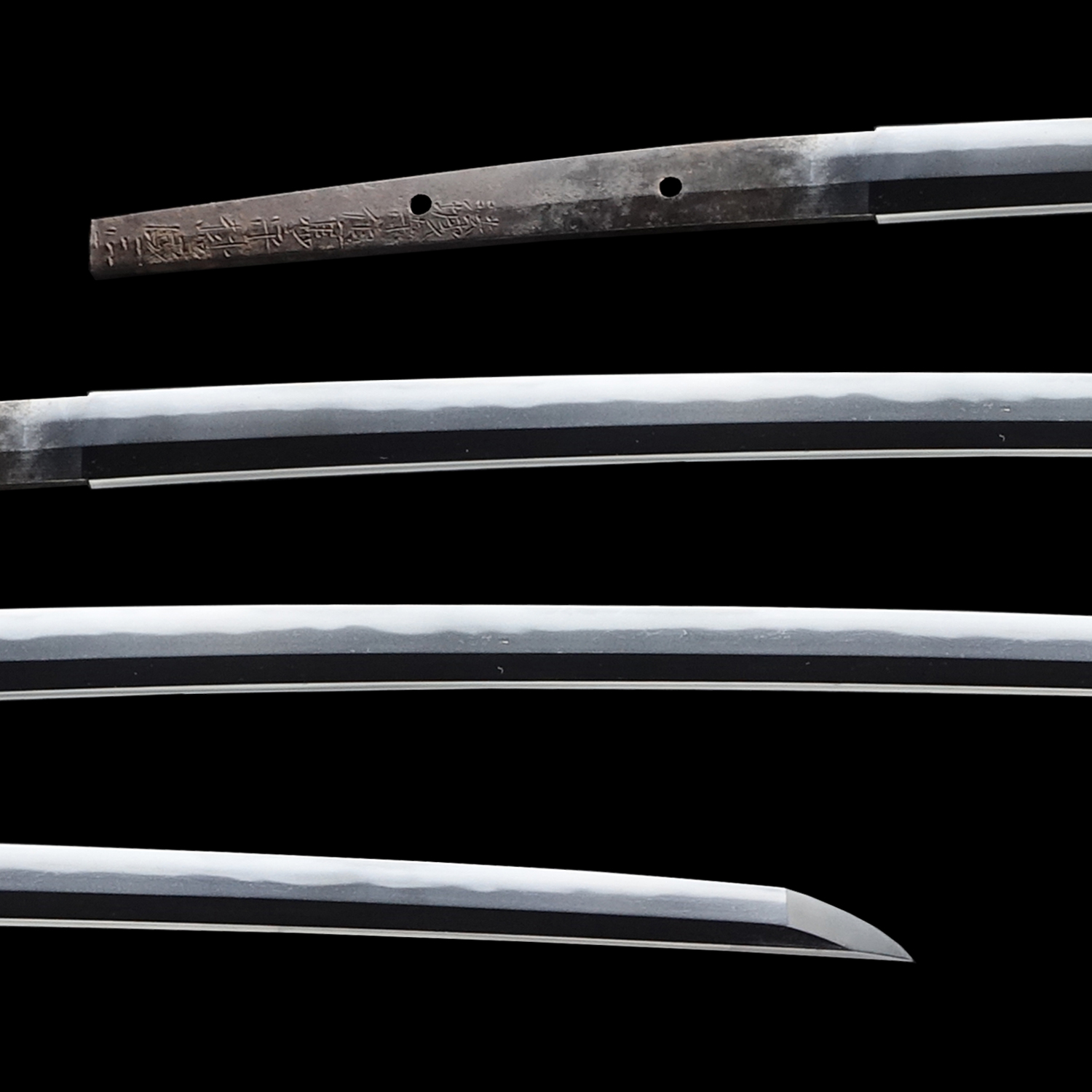
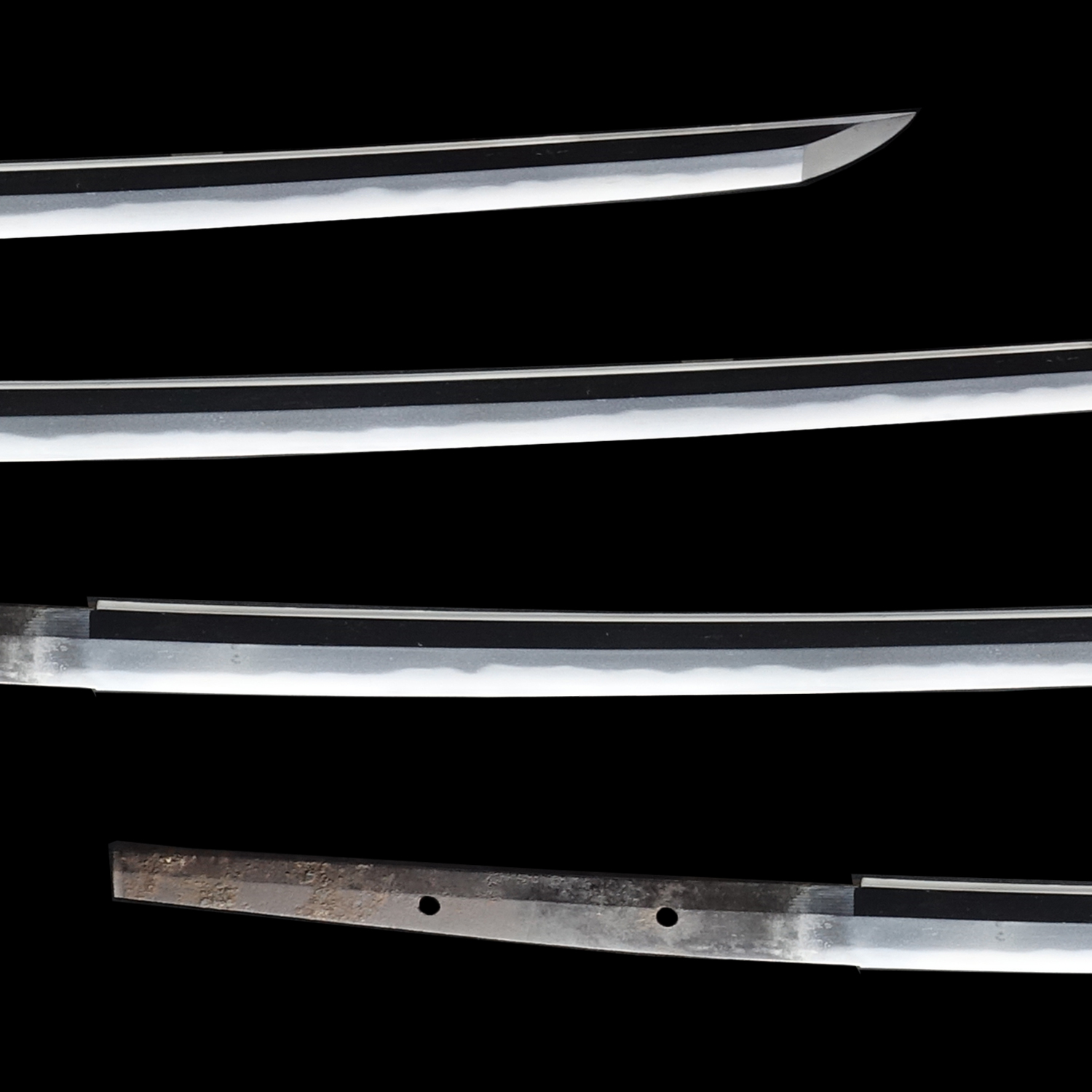
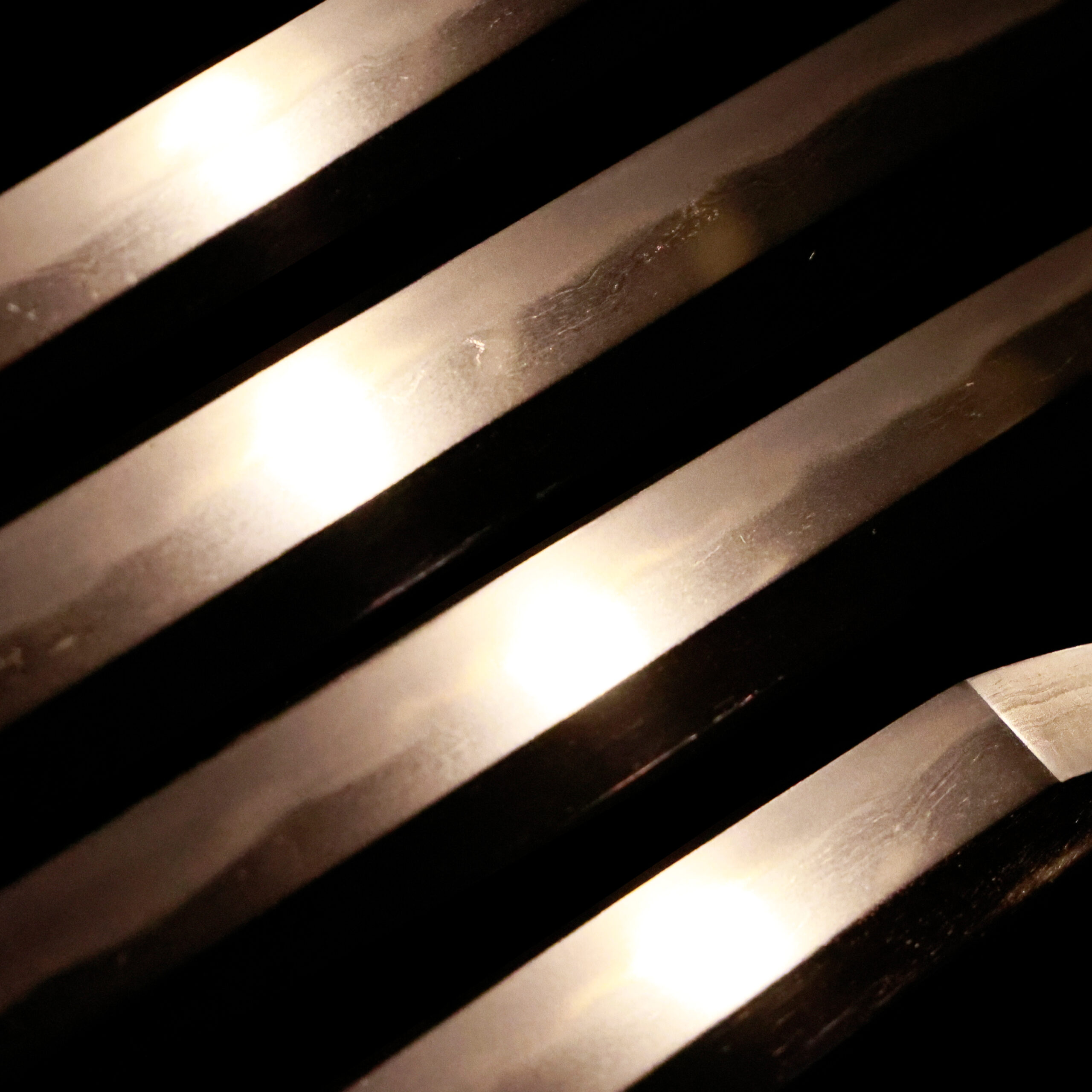
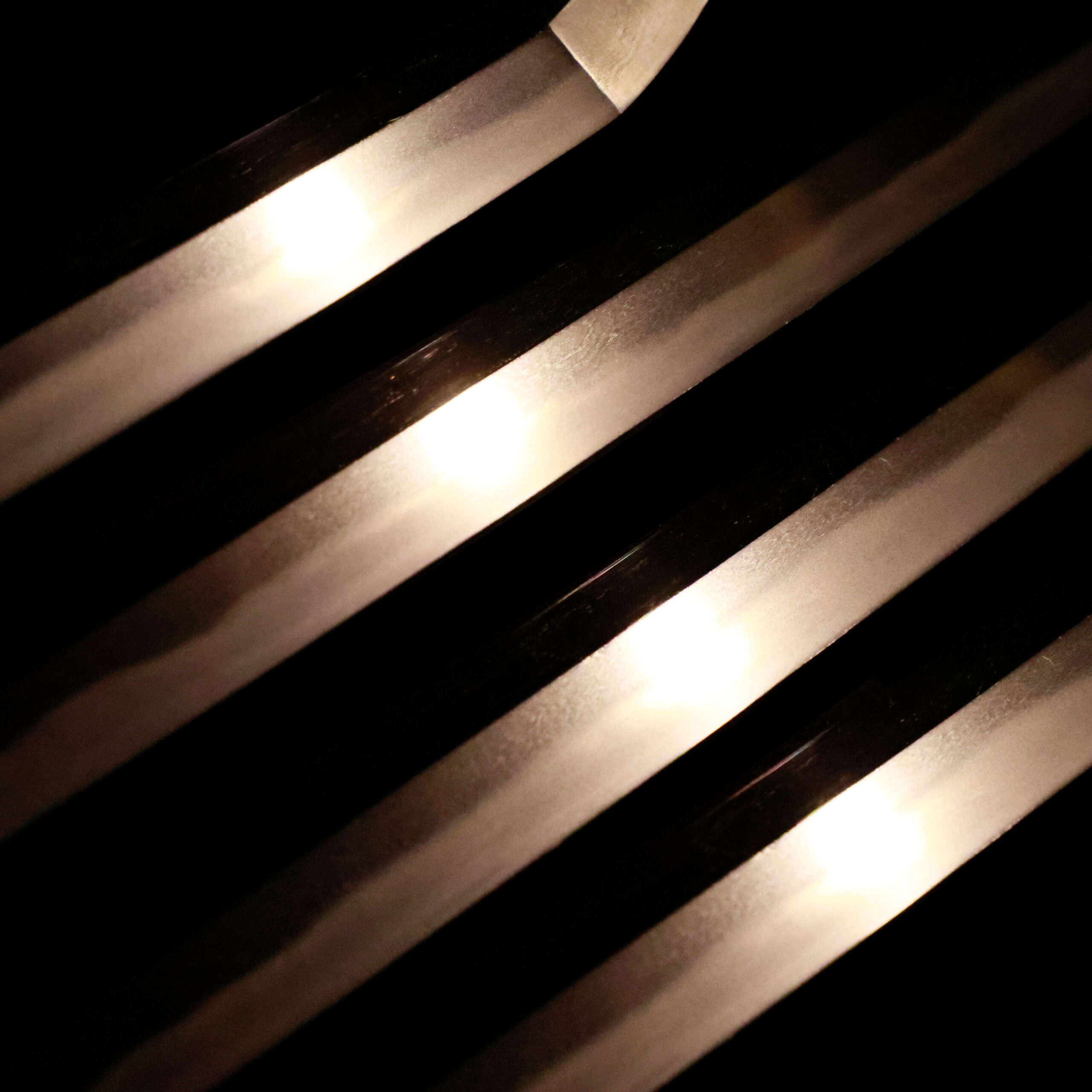

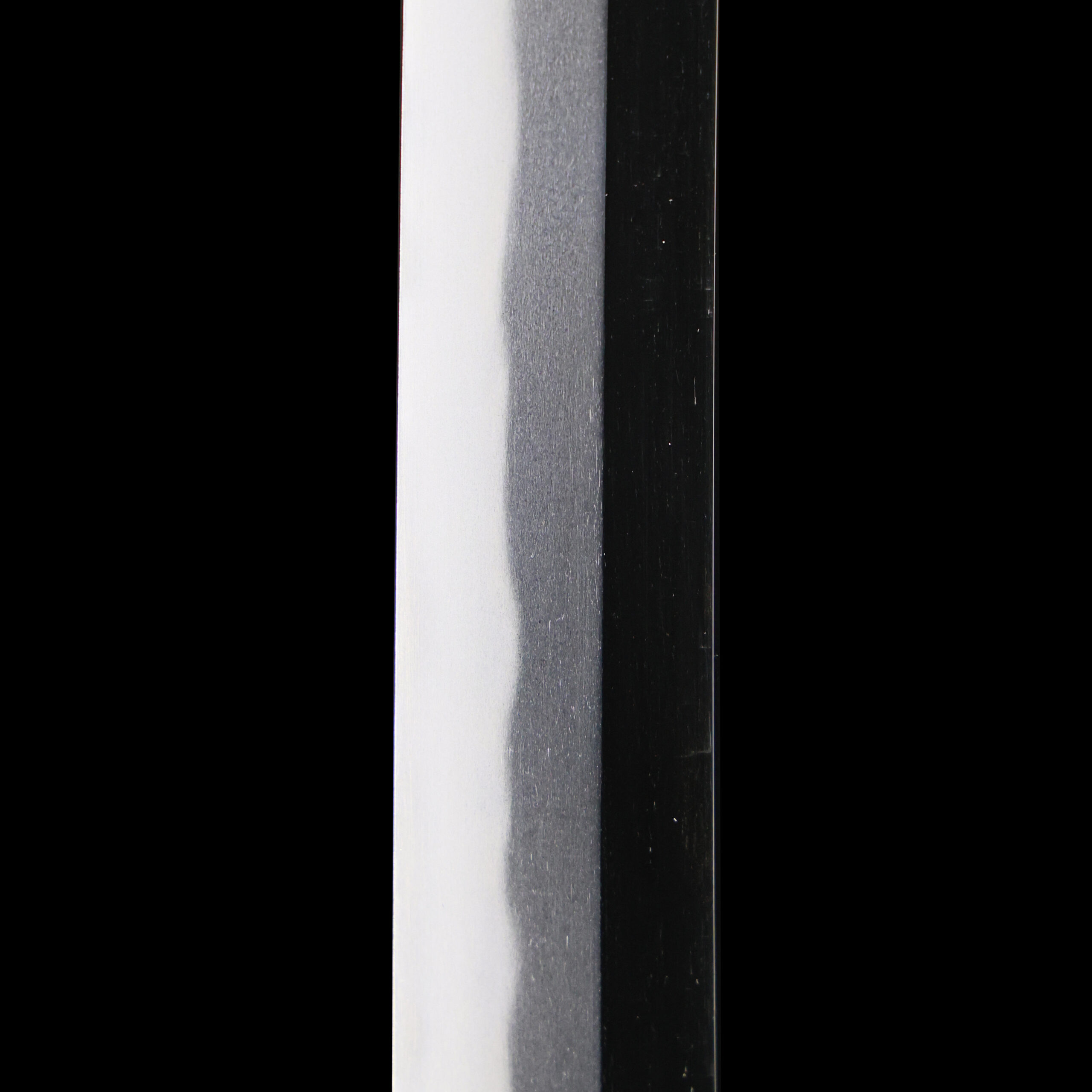
Kissaki:Kissaki is the tip of the Japanese sword.
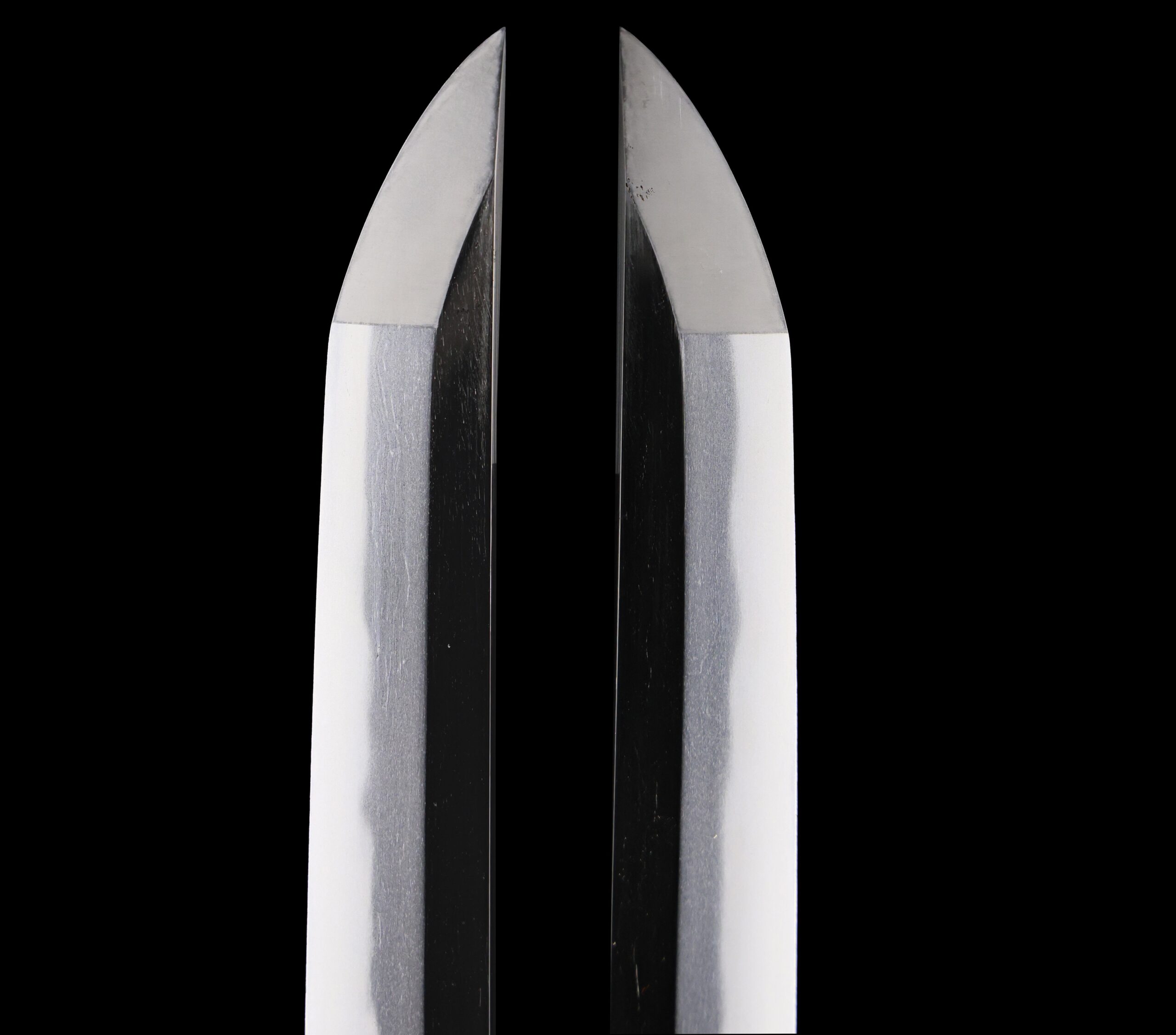
Nakago:Nakago is the tang of the Japanese sword.
Japanese swordsmiths left the black rust on the tang because it prevents red rust while the tang is in its handle. And the discoloration of the tang was created over time, and it is a great indicator for a Japanese sword specialist to estimate when the sword was forged.
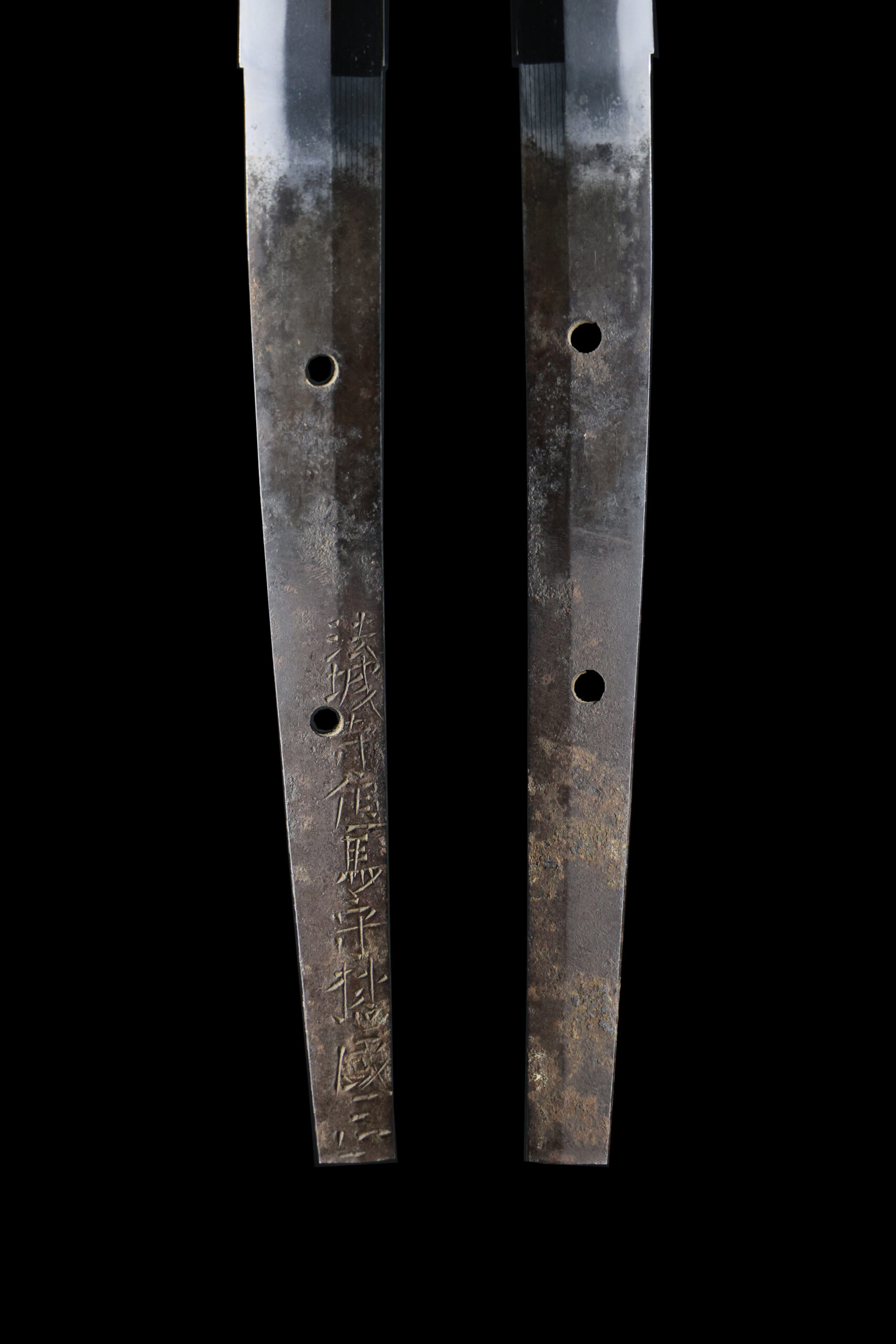
Koshirae: Koshirae is the mounting of the Japanese sword. There are several parts that consist of Koshirae such as Saya(Scabbard), Tsuka(Handle), Tsuba(Handguard).
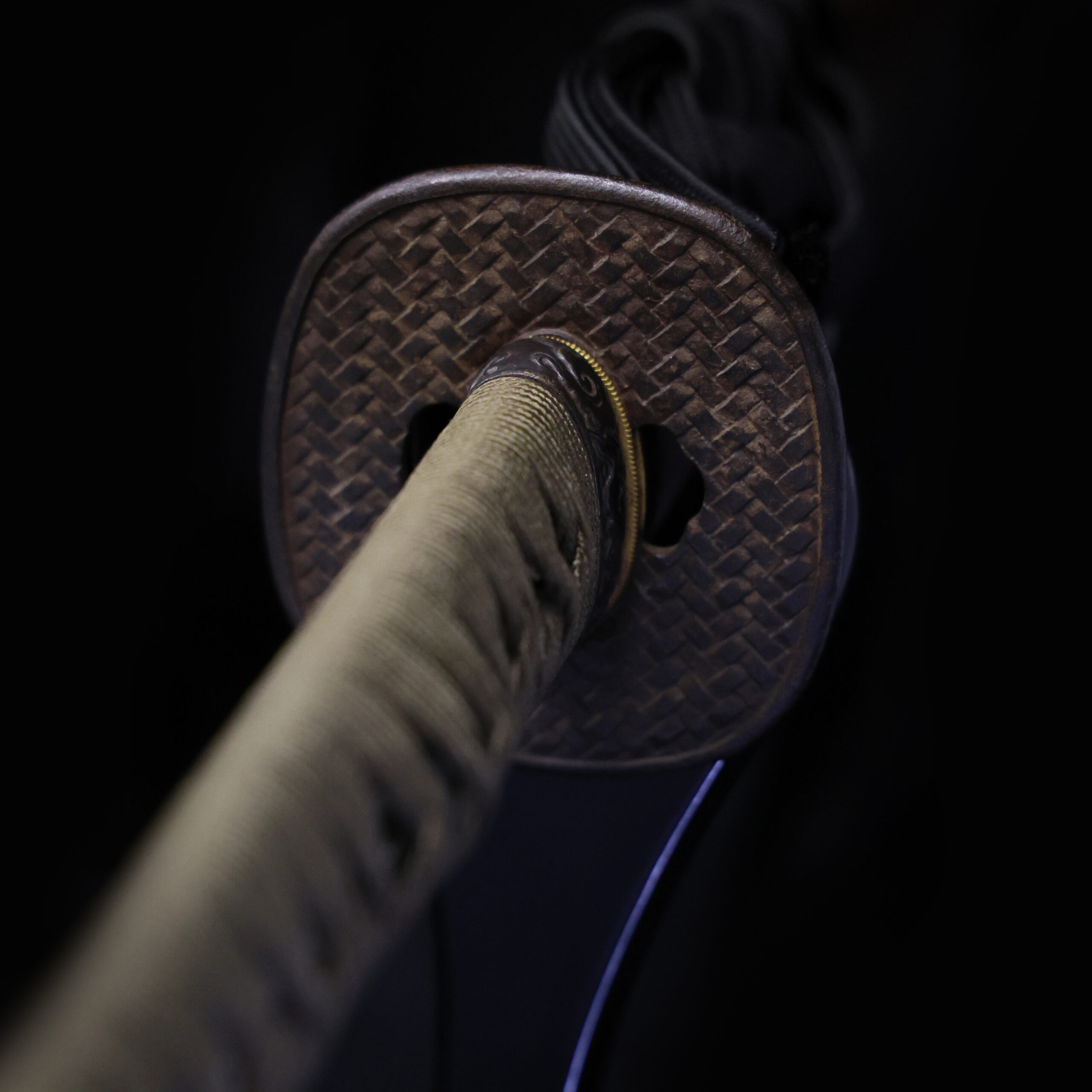
Fuchi-Kashira:A pair of matching sword fittings that cover the upper and bottom parts of its sword hilt.
The theme of this Fuchi-Kashira is the Unryu Zu (雲龍図). It is a combination of dragons (龍) and clouds (雲). Regarding the cloud pattern, clouds bring rain and snow, and their movements significantly affect the weather of the day. Due to its supernatural power, a theory says that gods, spirits, and dragons dwell in the clouds. As mentioned in the dragon design above, there is a religion that worships the dragon as a water god in Japan. It might be one of the reasons why the combination of dragon and clouds motifs is often seen even in sword mountings.
Also, clouds bring blessed rain and snow, and their movements significantly affect the day’s weather. Due to its supernatural power, a theory says that gods, spirits, and dragons dwell in the clouds. In Japan, there is a belief that worships dragons as water gods. Since rice cultivation has flourished in this country, people always treat water as an essential resource. We imagine some people wished for a plentiful harvest in the Unryu theme. From such a religious aspect, we could infer that dragon designs were familiar to people.
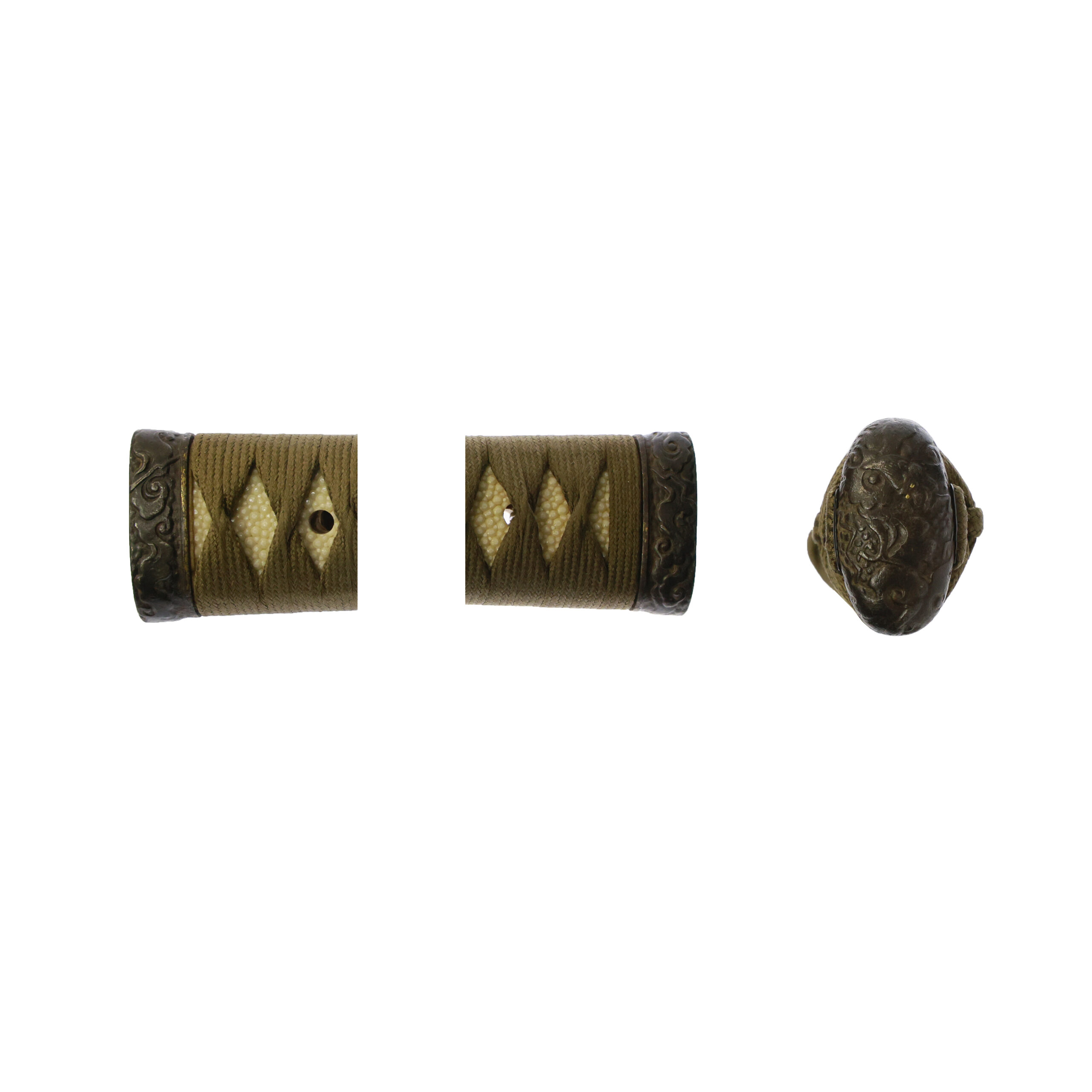
Tsuka and Menuki:Tsuka is the handle of the Japanese sword and Menuki is its decoration.
This menuki features a traditional design based on a cherry blossom flower basket (桜花籠, sakura hana-kago). The flower basket (hana-kago) has long been used in Japanese culture as a decorative vessel for arranging and displaying seasonal flowers, symbolizing an appreciation for nature’s beauty and the passing of time.
The cherry blossom (sakura) depicted in this design is more than just a flower—it represents one of the most profound symbols in Japanese aesthetics. It embodies the concept of “mono no aware” (物のあはれ), the deep and emotional appreciation for the transient beauty of life. Blooming brilliantly but briefly each spring, cherry blossoms have long reminded people of the delicate balance between joy and impermanence.
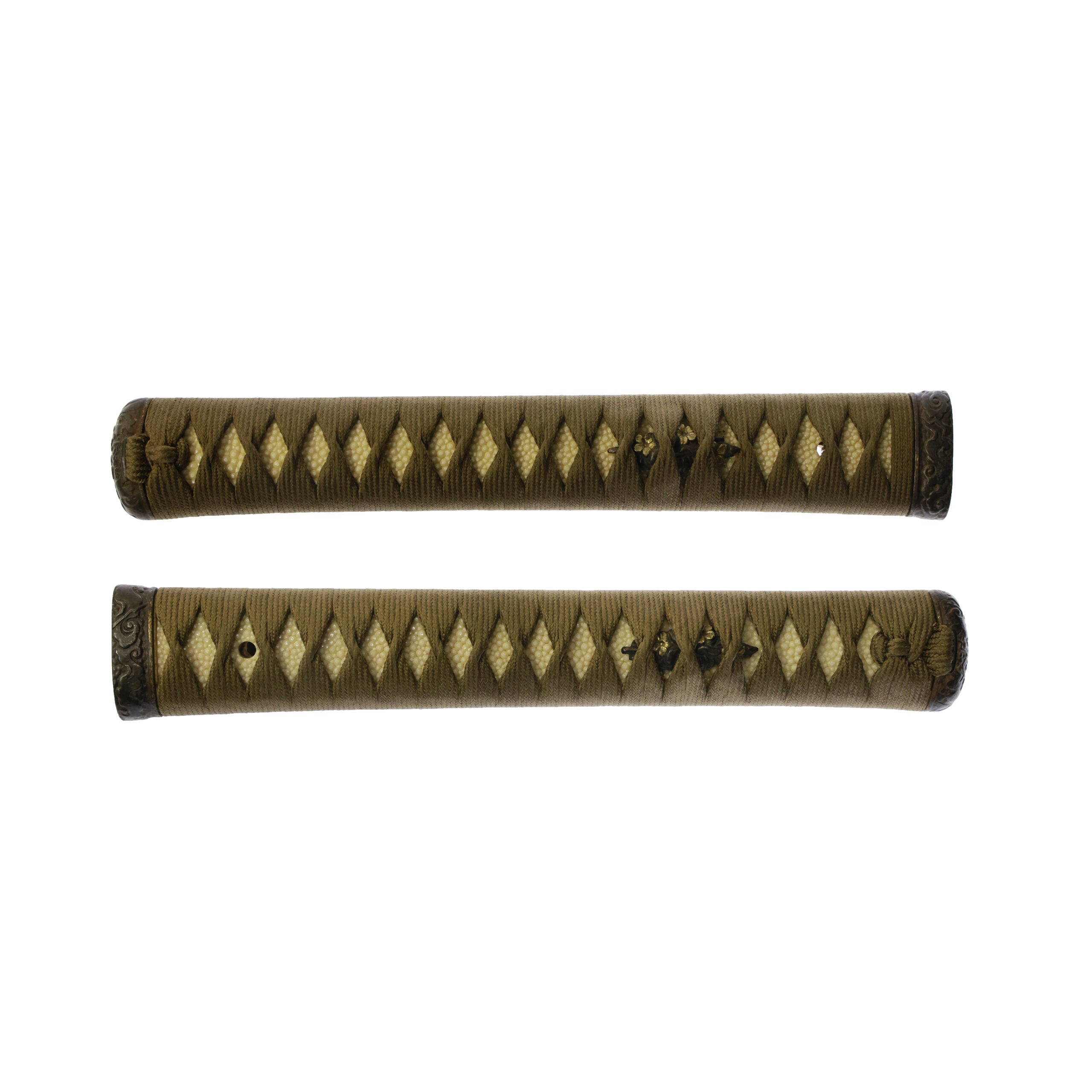
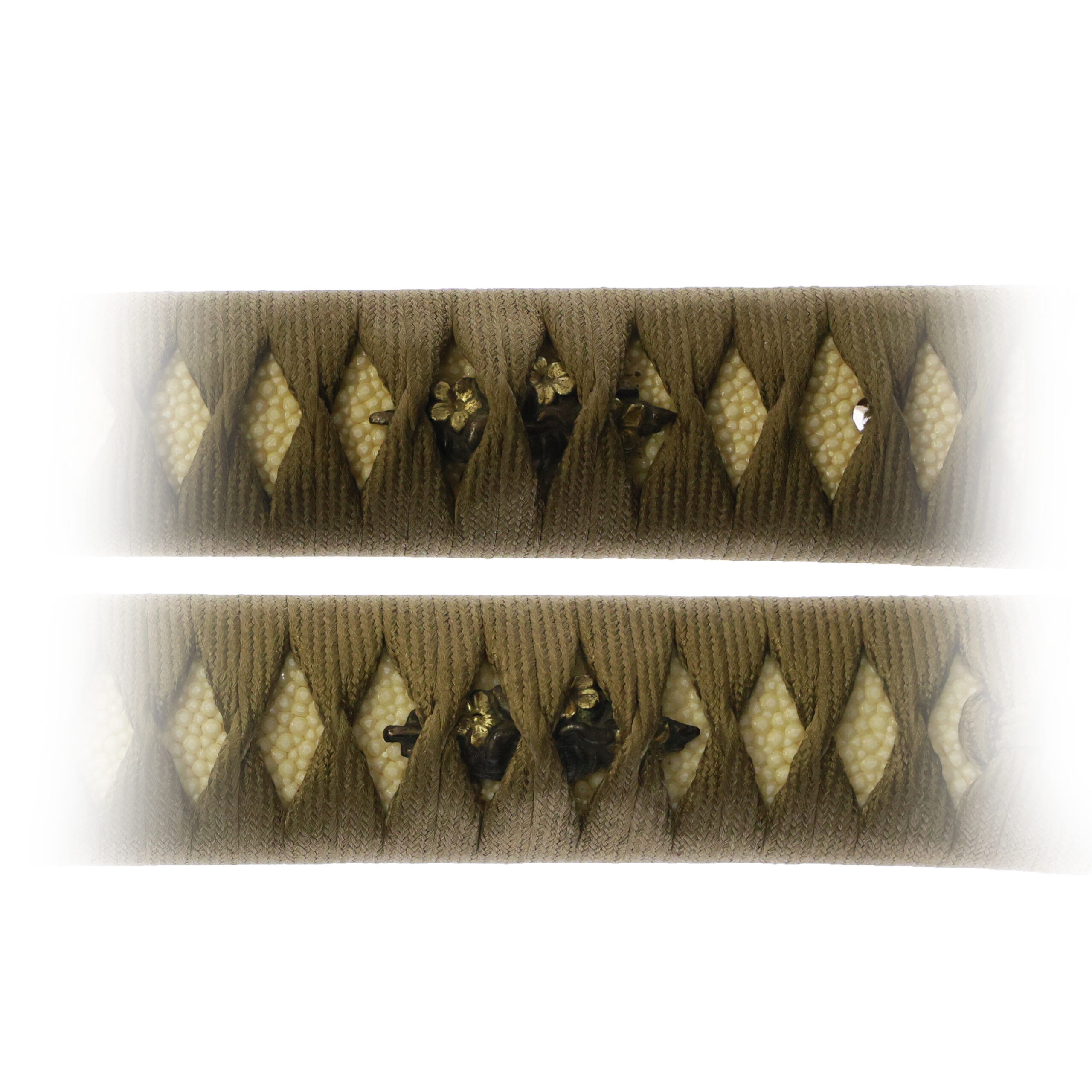
Tsuba and Habaki:Tsuba is the handguard for the Japanese Sword and Habaki is the equipment to make the blade not touch its scabbard inside. It prevents the blade from getting rusty and chipped.
This tsuba features a design incorporating the ajiro pattern (網代文様), a traditional Japanese woven motif. The term ajiro originally referred to a type of fence or trap made by weaving together bamboo or wood, used in rivers to catch fish. Over time, the crisscross pattern of these woven structures evolved into a decorative motif.
The ajiro pattern is believed to have apotropaic properties—that is, it serves as a charm to ward off evil spirits or misfortune. The name itself comes from the idea of using bamboo or wood as a substitute (“shiro” 代) for a net (“ami” 網). Because of this symbolism, ajiro patterns have traditionally been used in interior decorations such as wallpaper and ceiling panels, reflecting the human desire to protect the home and family from unseen threats or spiritual harm.
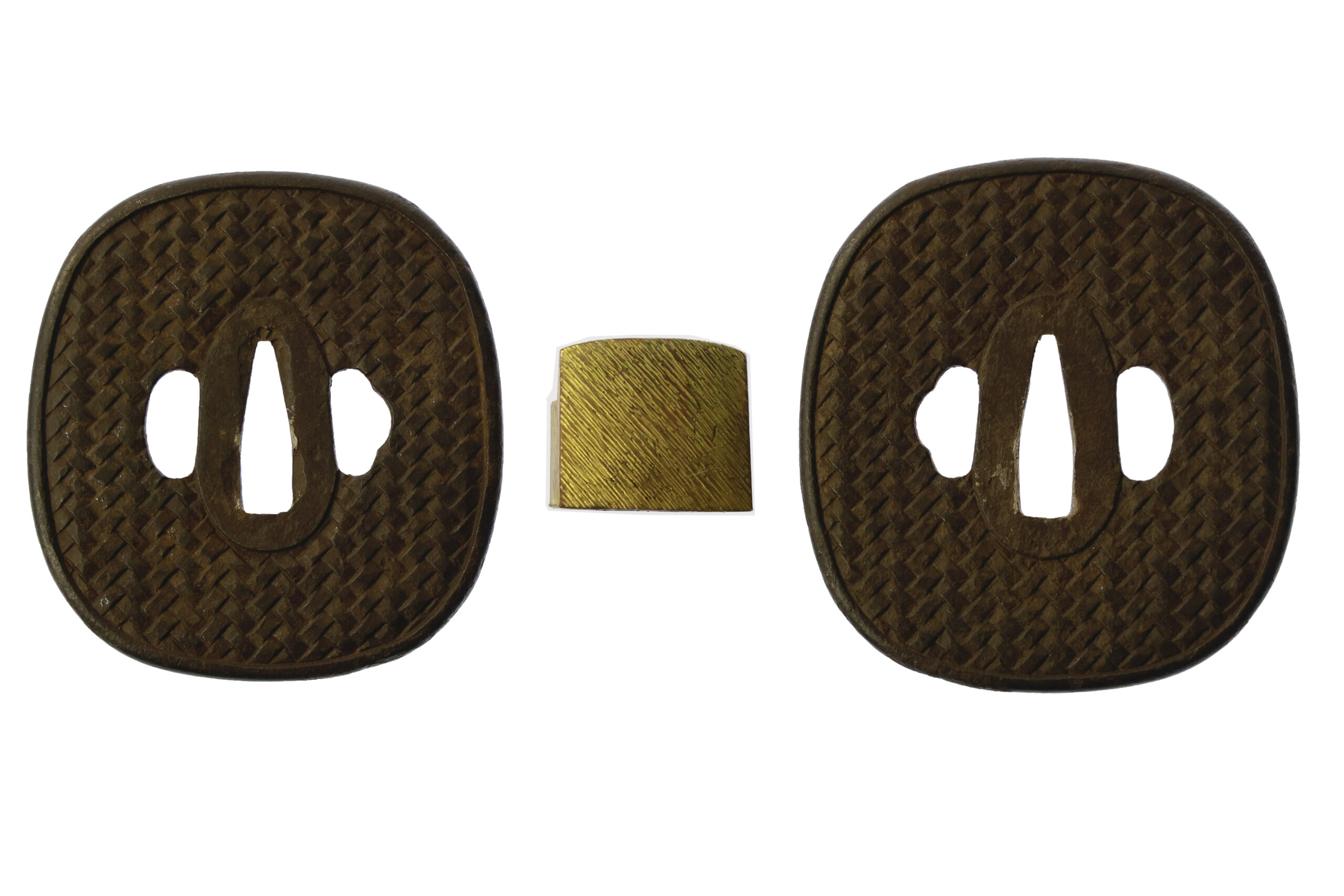
Saya: Saya is the scabbard for the Japanese sword.
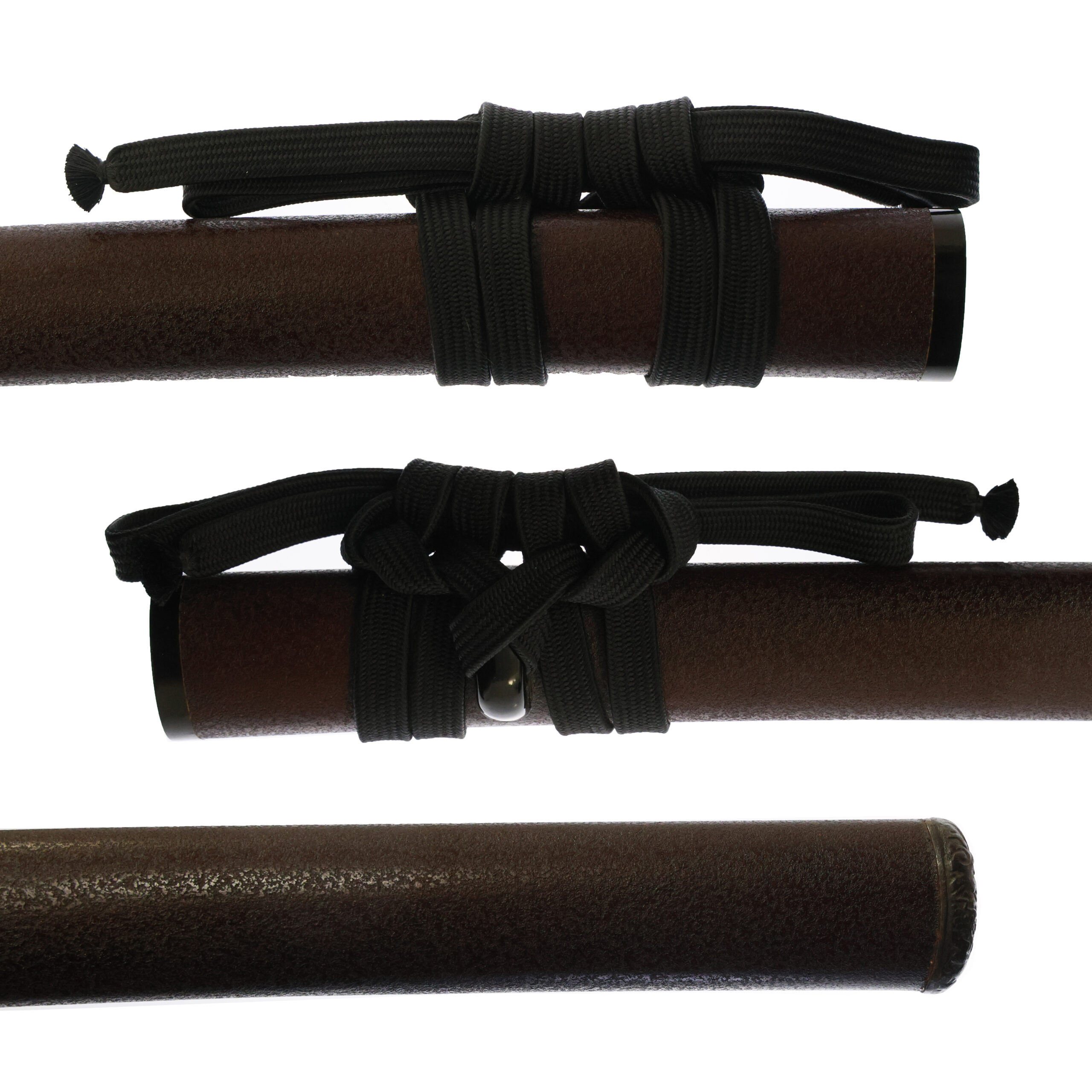

Authentication Paper:NBTHK Tokubetsu Hozon Certificate for the blade (No.1023365)
NBTHK, also known as Nihon Bijutsu Touken Hozon Kyokai (the Society for the Preservation of the Japan Art Sword), is one of the oldest Japanese sword appraising organizations in modern-day Japan. They authenticated the blade on December 12th in the 6th year of Reiwa (2024). They appraised it as Tokubetsu Hozon Touken, the blade especially worth preserving for Japanese society. The purchaser will receive this original certificate as well. We can also translate what is written into English and make a PDF file for your record if you request.

Registration Number : Tokyo 124171
The Board of Education in Tokyo issued a registration paper for this sword . It is called Jyu Token Rui Torokusho(銃刀剣類登録証). Bunkacho(The Agency for Cultural Affairs) acknowledges a Japanese sword with this paper as a work of art.
The sword needs to be traditionally hand-forged and made of Tamahagane carbon steel to be registered in the system. With this paper, its owner in Japan can legally own an authentic Japanese sword. Based on this registration number, we will apply for its export permit.
This paper will need to be returned to the board of education when the sword is being shipped abroad, but you can receive a copy of it. An English translation of this registration paper is available on request.
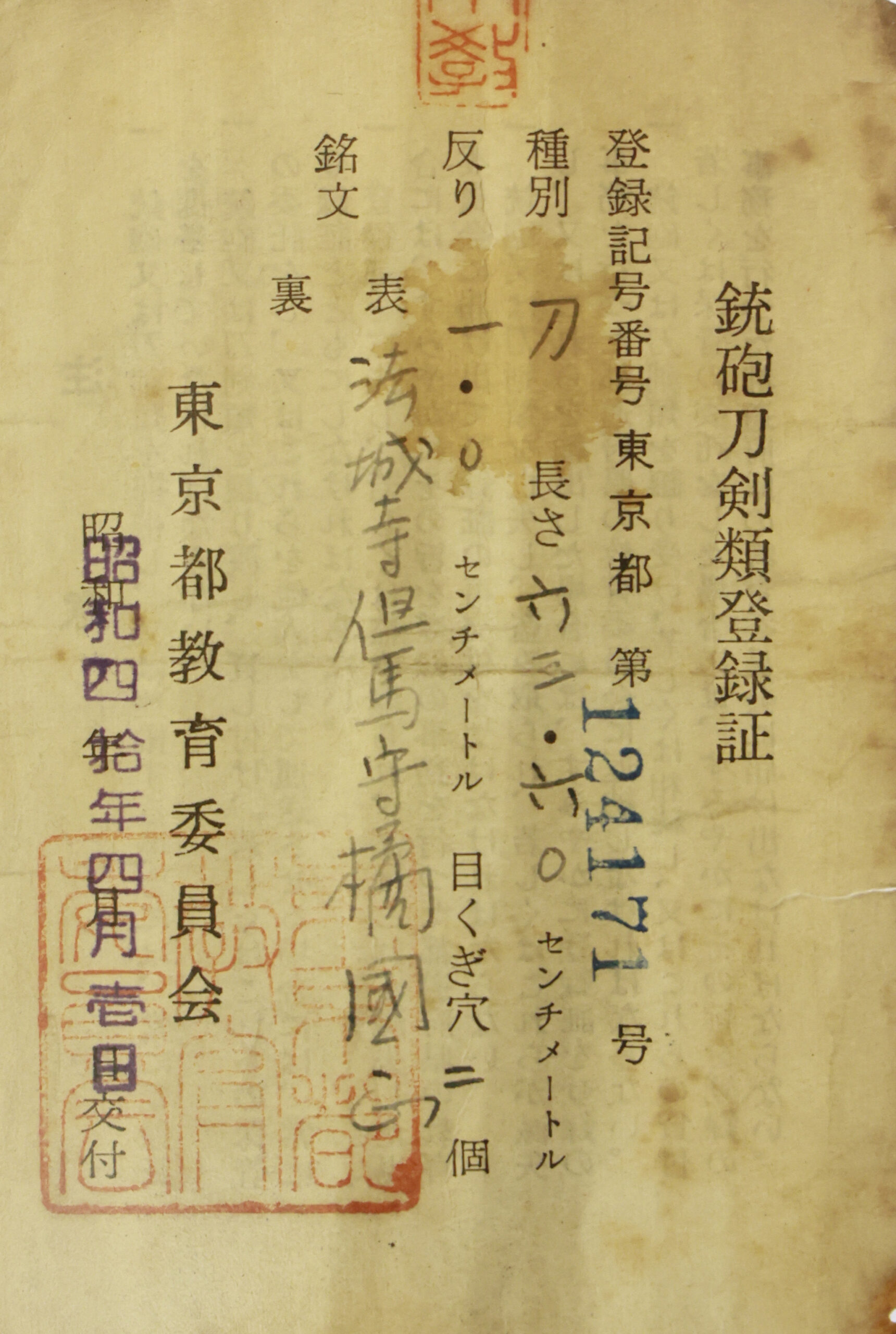
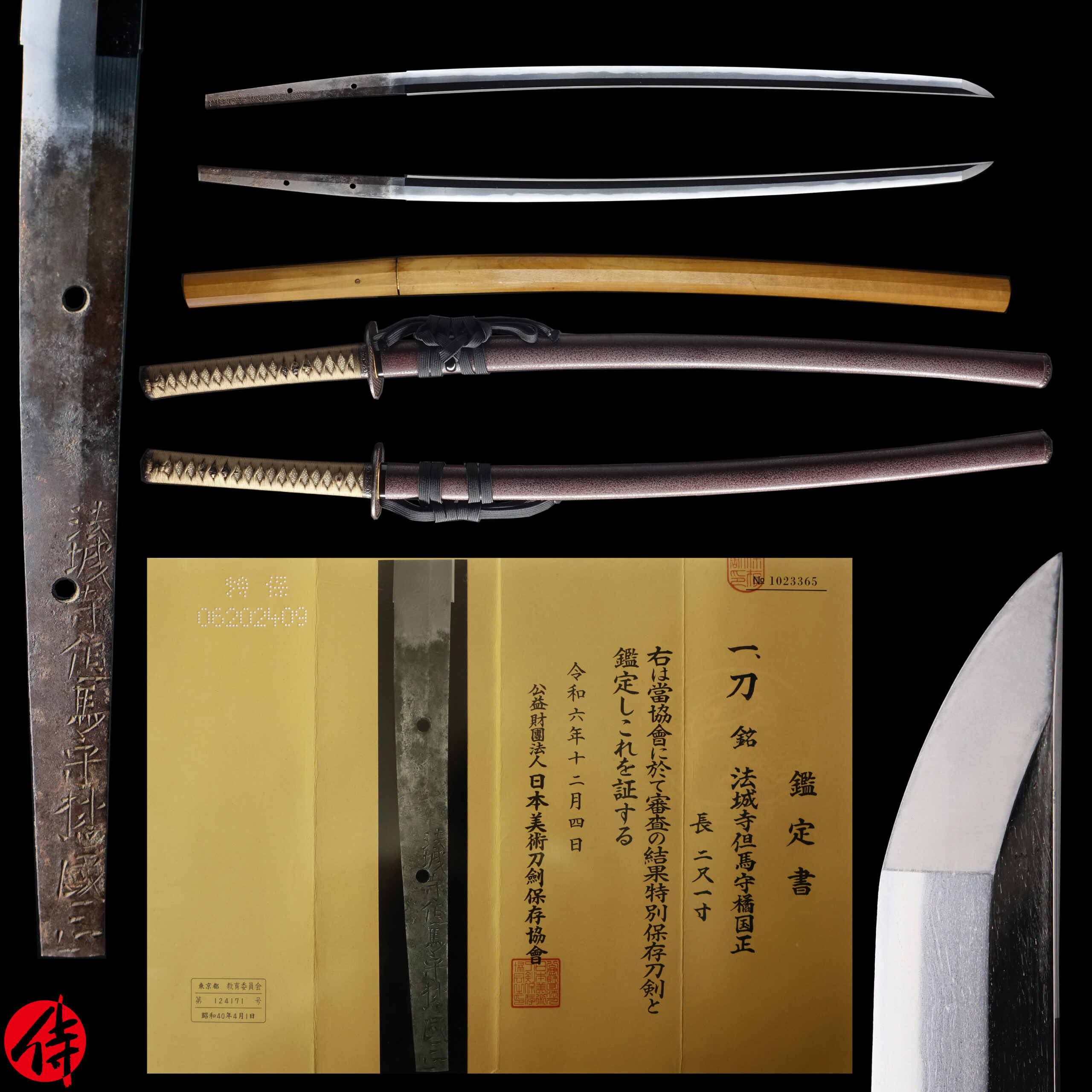
—————————————————————–
【About us】
Samurai Museum is located in Tokyo, Japan, exhibiting antique artifacts related to the Samurai history. Samurai Museum Shop is the place for those who are interested in Japanese culture and craftsmanship. We deal with antique Samurai swords/armor, traditional crafts made in Japan and so on.
【Japanese Sword& Export Process】
The Japanese swords we deal with are hand-forged edged swords made in Japan. It was made from the traditional carbon steel called TAMAHAGANE(玉鋼). Samurai Museum is familiar with the proper legal procedure for an antique/ authentic Japanese sword to be exported from Japan. We have sent more than 1000 Japanese swords for the past few years (~2025) to amazing owners who appreciate its historical value.
Each Japanese sword is registered under the Agency for Cultural Affairs and the Board of Education in Japan. They issue a registration paper for each Japanese sword for its owner in Japan to legally possess it. The Japanese sword with its registration paper means it was traditionally hand-forged in Japan.
To legally export the sword from Japan to other countries, we will have to apply for its permit to the Agency for Cultural Affairs(Bunkacho) and return the original registration paper to the Board of Education. It normally takes around 2-4 weeks to receive this permit after submitting required documents. And we would like you to expect at least 1-1.5 months for your order to arrive at your given address after you ordered. For more detailed info, please click here.
It is allowed for residents in Japan to own authentic Japanese swords without a special license as long as they come with registration papers. Please feel free to contact us if you are a resident of Japan, whether temporarily or permanently. We will also assist you when you leave Japan and need to obtain the export permit.
【Payment Method】
We accept payment through Stripe (Credit card), PayPal, Apple Pay or ChromePay, all of which are secure payment methods. Also, you don’t need to make an account on Stripe for the checkout. If you prefer other payment method, please contact us. After confirming your payment, we will apply for an export permit. You may either pay in JPY, USD, AUD, CAD,EUR CHF or GBP. The price is set in Japanese Yen. Prices in other currencies are automatically calculated based on the latest exchange rate.

* If the amount is above 1 million JPY, Stripe or wire transfer will be the only options for payment.
【Shipping】
We have shipped authentic Japanese swords to the USA, Canada, Mexico, Germany , Belgium, France, Finland, UK, Hong Kong, Australia. If you don’t live in these countries and like to order, please contact us first before making a purchase. We offer Free International Shipping as long as we can send antique Japanese swords by EMS.
We normally ship by EMS(Express Mail Service) provided by Japan Post. We will send you a tracking number for your order as soon as we hand it to the post office. We will put 100 % insurance on the shipping document without any extra charge. Based on the total amount, there might be a duty tax or other fee for you to pay, depending on the countries. We use package cushioning to protect the item and put it in a PVC pipe, which is one of the most secure packages because of its durability.
It will normally takes 5-14 days for the item to arrive at your given address after we dispatch it. Time of delivery is estimated as accurately as possible by the carrier but does not take into account any delays beyond our control such as by inclement weather, post office holiday seasons.
* If you live in Australia and like to purchase an authentic Japanese sword, please click here to know the detail.
* If you live in the UK and like to purchase an authentic Japanese sword, please contact us first and click here to know the detail.

【Review】
Here is one of the reviews we received from a customer who purchased an authentic Japanese sword from us. For more reviews, please click here.
“My experience overall with the whole process was wonderful. I had many questions about the history and process to purchase these treasures. All my questions were answered very timely and complete. The staff is very knowledgeable and very well versed if any questions do arise.”
【How to make sure the condition】
Please keep in mind that what you are going to purchase is an antique item. We uploaded high resolution photos for you to check its condition thoroughly. If you like to see more photos with different angles, please feel free to contact us. We will be happy to send them to you so that you can make informed decision. It is essential for us to know that you are happy with your choice of a sword. and we are prepared to use the best of our ability to serve you.
【How To Contact Us】
Please contact us through email, Facebook Messenger or Live Chat if you have any questions. You can find each icon on the right side of the website. Please click one of them to reach us. We will reply to you within 1-2 business days.
【The Art of Nihonto (Japanese Sword)】
Samurai’s history is a profound, eloquent legacy of ancient Japanese warriors in which millions of people worldwide are being fascinated. If you like to find out the art of Nihonto, please click here.
【A Guide to Japanese Sword Maintenance】
After acquiring an genuine Japanese sword, it is also important to know how to take good care of it. Here is the special video for you. Mr. Paul Martin, Japanese sword expert, shows you how to give proper maintenance to your sword. By mastering how to clean the Japanese sword, its aesthetic beauty will last forever.
When you purchase a Japanese sword from us, you can get a Free Japanese sword maintenance kit. It comes with four tools(Choji Oil, Uchiko Whetstone Powder, Peg remover, Oil Applicator). By watching the video instruction above , you can enjoy learning how to maintain your Japanese sword while appreciating it. If you have any difficulty assembling the sword or cleaning the blade, you can feel free to contact us.
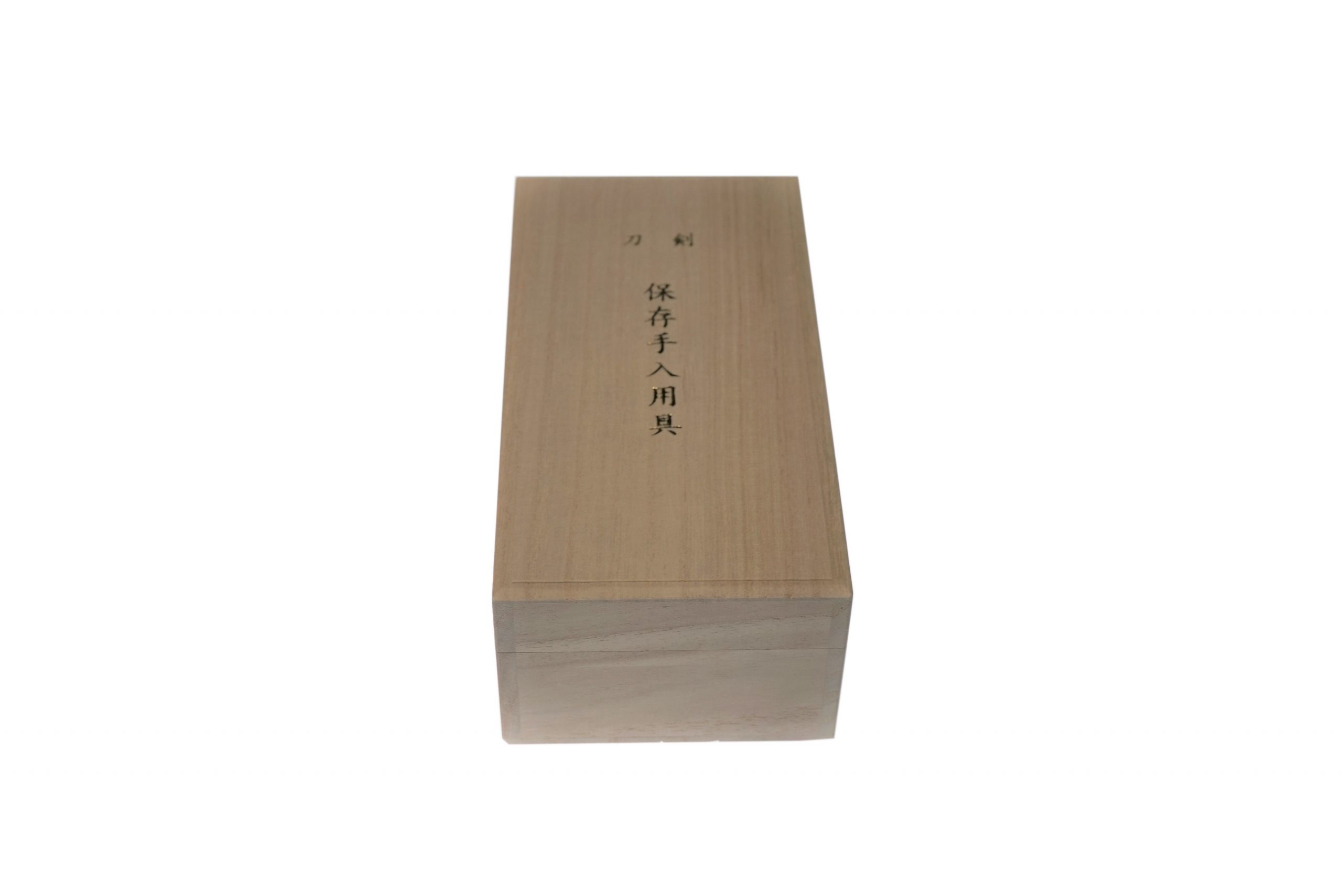
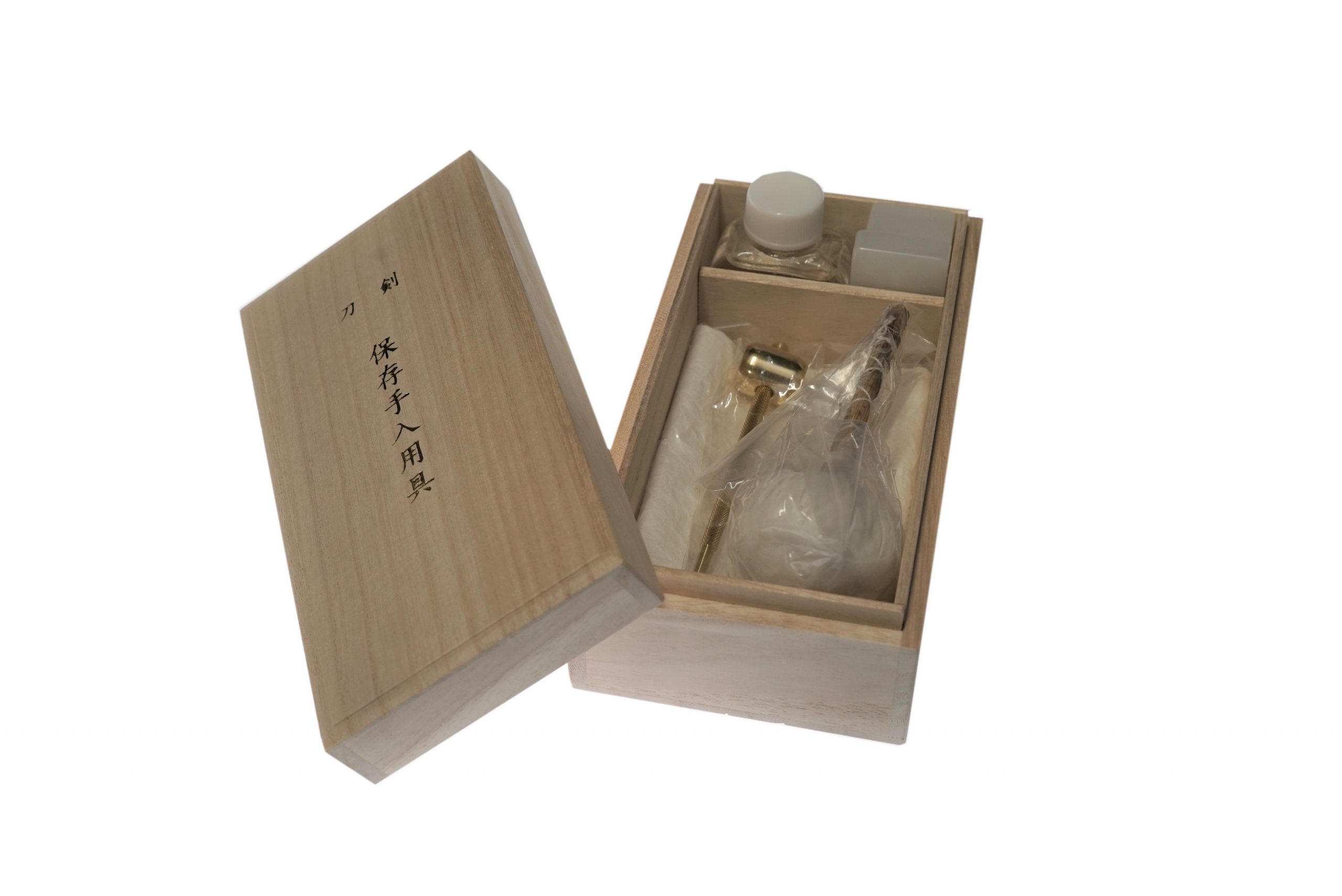
MORE ANTIQUE JAPANESE SWORD FOR SALE
SWORDS WITHOUT CERTIFICATES FOR SALE
LEARN JAPANESE SWORD TERMINOLOGY
Thank you for reading all the information on the page. If you have any difficulty choosing the right Japanese sword for you, we will be more than happy to help you find the one that speaks to you the most. Please feel free to contact us.
